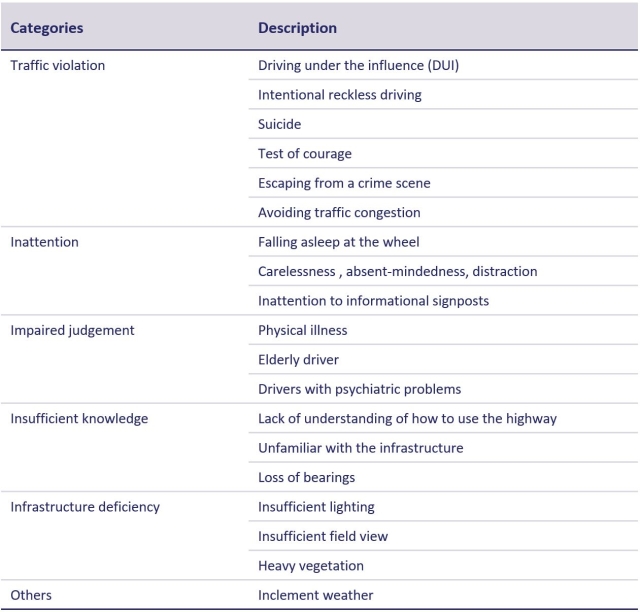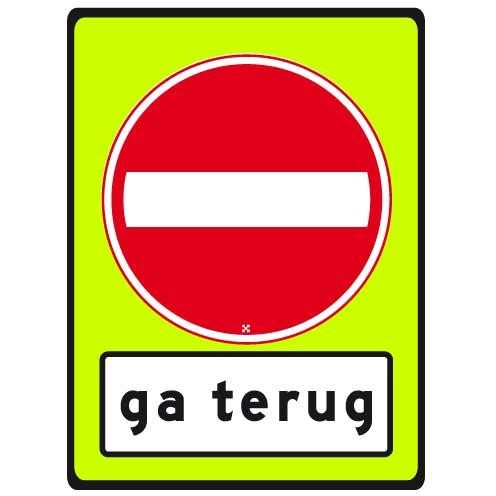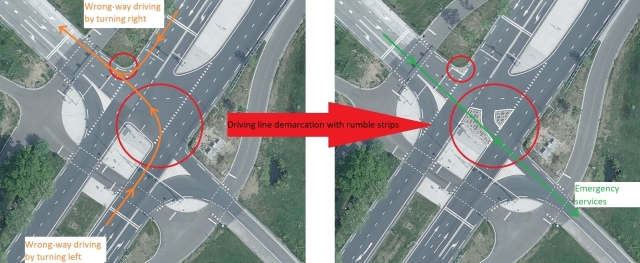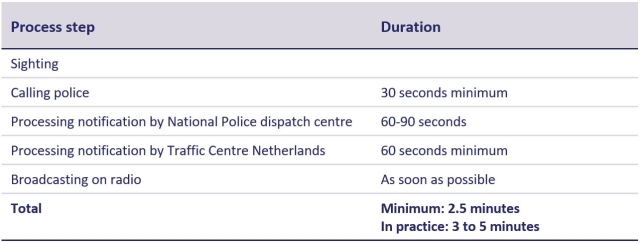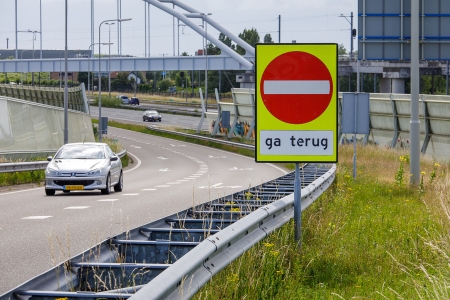Below you will find the list of references that are used in this factsheet. On our library portal you can find more literature on this topic.
[1]. Davidse, R.J., Duijvenvoorde, K. van & Louwerse, W.J.R. (2022). Spookrijders, spookritten en spookrijongevallen. Een analyse op basis van politiedossiers [Wrong-way drivers, events and crashes. An analysis based on police files]. R-2022-3 [Summary in English]. SWOV, Den Haag.
[2]. Blokpoel, A. & Niet, M. de (2000). Spookrijders en frontale botsingen op autosnelwegen. Omvang en ontwikkeling van de onveiligheid door het rijden in de verkeerde rijrichting in de periode t/m 1998. R-2000-16. SWOV, Leidschendam.
[3]. Verkeerskunde (2006). Maatregelen veroorzaken geen daling in aantal spookrijdoden. Verkeerskunde. Accessed on 28-11-2022 at www.verkeerskunde.nl/maatregelen-veroorzaken-geen-daling-in-aantal.10111.lynkx.
[4]. Vias institute (2022). Briefing 'Spookrijders'. Vias institute, Brussel.
[5]. Gerlach, J. & Seipel, S. (2012). Falschfahrten auf Autobahnen. Schlussbericht Dezember 2012. Bundesanstalt für Strassenwesen, Bergisch Gladbach.
[6]. Scaramuzza, G. & Cavegn, M. (2007). Wrong-way drivers: extent – interventions. Paper presented at Young Researchers Seminar 2007, 27-30 May 2007, Brno, Czech Republic.
[7]. Vicedo, P. (2007). Preventing and managing ghost-driver incidents: the French experience. In: Tollways, vol. 4, nr. 3, p. 43-49.
[8]. NTSB (2012). Wrong-way driving. Highway Special Investigation Report. PB2012-917003. National Transport Safety Board, Washington.
[9]. Morena, D.A. & Leix, T.J. (2012). Where these drivers went wrong. In: Public Roads, vol. 75, nr. no. 6, FHWA-HRT-12-004.
[10]. Zhou, H., Zhao, J., Pour-Rouholamin, M. & Tobias, P.A. (2015). Statistical characteristics of wrong-way driving crashes on Illinois Freeways. In: Traffic Injury Prevention, vol. 16, p. 760-767.
[11]. Kemel, E. (2015). Wrong-way driving crashes on French divided roads. In: Accident Analysis & Prevention, vol. 75, p. 69-76.
[12]. Zhou, H., Zhao, J., Reisi Gahrooei, M. & Tobias, P.A. (2016). Identification of contributing factors for wrong-way crashes on freeways in Illinois. In: Journal of Transportation Safety and Security, vol. 8, nr. 2, p. 97-112.
[13]. Jalayer, M., Pour-Rouholamin, M. & Zhou, H. (2018). Wrong-way driving crashes: a multiple correspondence approach to identify contributing factors. In: Traffic Injury Prevention, vol. 19, p. 35-41.
[14]. Ponnaluri, R.V. (2016). The odds of wrong-way crashes and resulting fatalities: a comprehensive analysis. In: Accident Analysis & Prevention, vol. 88, p. 105-116.
[15]. Doctor, M. (2016). Wrong way driving: new focus on a persistent problem. TRB Webinar April 20, 2016.
[16]. Xing, J. (2014). Characteristics of wrong-way driving on motorways in Japan. In: IET Intelligent Transport Systems, vol. 9, nr. 1.
[17]. Davidse, R.J. (2002). Verkeerstechnische ontwerpelementen met oog voor de oudere verkeers¬deelnemer. Een literatuurstudie [Road design elements taking the older road user into account. A literature study]. R-2002-8 [Summary in English]. SWOV, Leidschendam.
[18]. Finley, M.D., Venglar, S.P., Iragavarapu, V., Miles, J.D., et al. (2014). Assessment of the effectiveness of wrong way driving countermeasures and mitigation methods. Report FHWA/TX-15/0-6769-1. Texas A&M Transportation Institute, College Station, Texas.
[19]. Zhou, H., Zhao, J., Fries, R., Gahrooei, M.R., et al. (2012). Investigation of contributing factors regarding wrong-way driving on freeways. Research Report FHWA-ICT-12-010. Illinois Center for Transportation, Springfield.
[20]. CROW (2013). Handboek Wegontwerp - Gebiedsontsluitingswegen. Publicatie 330. CROW, Ede.
[21]. CROW (2015). Richtlijnen voor de bebakening en markering van wegen. Publicatie 207. CROW, Ede.
[22]. RWS (2021). Richtlijn Ontwerp Autosnelwegen. Veilige Inrichting van Bermen (VIB). Versie 11. Ministerie van Infrastructuur en Waterstaat, Rijkswaterstaat, Grote Projecten en Onderhoud (GPO).
[23]. Zengerink, L., Prey, A., Delis, C., Jelijs, B., et al. (2022). Ga terug. Risicoinventarisatie onvolledige aansluitingen op spookrijden. Goudappel, Deventer.
[24]. Brevoord, G.A. (1998). Spookrijden. Adviesdienst Verkeer en Vervoer AVV, Rotterdam.
[25]. Lin, P.-S., Ozkul, S., Guo, R. & Chen, C. (2018). Assessment of countermeasure effectiveness and informativeness in mitigating wrong-way entries onto limited-access facilities. In: Accident Analysis & Prevention, vol. 116, p. 79-93.
[26]. Rijkswaterstaat (2022). Spookrijden: een gevaar op de weg. Rijkswaterstaat. Ministerie van Infrastructuur en Waterstaat. Accessed on 24-05-2022 at www.rijkswaterstaat.nl/wegen/ongeval-en-pech/spookrijden.
[27]. OvV (2020). Spookrijongeval A73. Leren van verkeersongevallen. Onderzoeksraad voor Veiligheid, Den Haag.
[28]. Brink, H. & Matton, J.C. (1999). Regeltactieken spookrijden. Kader voor regeltactieken om weggebruikers te waarschuwen voor en/of te beschermen tegen spookrijders. Grontmij, De Bilt.
[29]. Royal Haskoning DHV (2018). Spookrijder A73 - Evaluatie meldingsfase incident november 2017. RoyalHaskoning Nederland B.V, Amersfoort.

